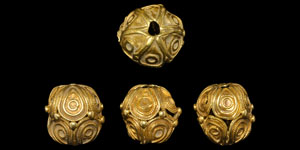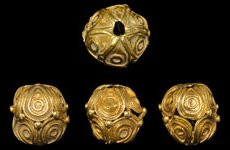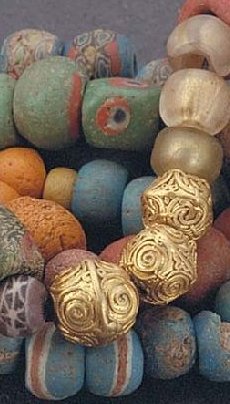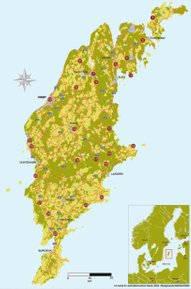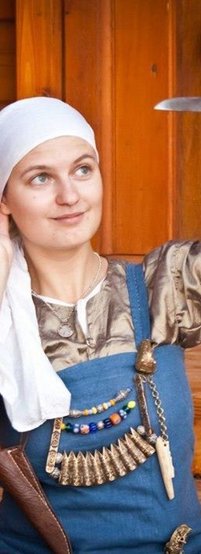Viking beads
At very close look at the beads can be view/magnified by this link:
http://www.timelineauctions.com/view.php?id=13244&image=image_1
A group of four sheet gold beads, each formed as a hollow bulb with granulation, filigree ovolo detail and applied rings.
9th century AD.
3.64 grams, 9.5-10 mm
Size :1/4"
Fair condition, two incomplete.
Provenance:
From a Canadian collection, ex Sotheby's Lord McAlpine sale, 17th February 1994.
I had a feel that these beads were of Scandinavian/Swedish origin. When consulting the curator at the National Historic Museum of Sweden, he confirmed this.
Even more he was stating:
"Yes we do have similar – if not even identical – gold beads from Gotland in our collections. They have inventory number SHM 13441:1-3 and are from Petes, Linde parish on Gotland. Beautiful little things and kind rare I would say".
As mentioned under the beads section, beads were very valuable. Golden beads are the far most rare of them, and would have only been worn by women of (very) high status.
Visiting a travelling exposition of the National Historic Museum of Sweden in Assen (provence Drenthe in Holland) in Spring 2012, I noticed similarlike golden beads in a bead necklace on display.
Link to exhibition with similarlike golden beads on display
Look here for a picture of an even more elaborate type of golden bead from Gotland.
Intruiging to discover that the vikings weren't the first to make such beautiful beads, as can bee seen on this picture.
These beads are from a 2,600 year old Celtic Tomb !
Viking artefacts from the isle of Gotland have a distict architecture of itself, as also can bee seen on the boar heads brooches and so called 'box brooches'. Also the 'fish' necklace pendants are unique within the viking area.
A nice overview of what is to bee seen of the viking age on Gotland see:
Link to the highlights of viking heritage on Gotland
also on this site a CD-R can be ordered with al kinds of pictures of beads excavated on the isle of Gotland..
On this picture a Gotlandic viking woman and how she could have worn this typical Gotlandic viking jewellry (see the boar head brooch, the fish pendants).
The real stuff on display see here.
Well. I could have been with these stones until after dark, but as my wife wanted to travel on.. well.. I see you again, some day, hogback stones from Gosforth. And if you happen to be there one day, do not forget that monument on the outside...
Further on with the Cumbrian hogbacktour !
In - yes, luckily again in - St. Peter's church in Heysham, there is a truly beautiful hogback stone. The guide told us, it had been studyied by Thor Ewing, a writer, in 2000. in 'Understanding the Heysham hogback' A tenth century sculpted stone monument and its context (link), Thor Ewing tells in detail what he dicovered on the both sides of this hogback stone.
Just being brought in the church as late as the 1970's accompanied with some protest here and there among the church visitors, considered as being a token of old paganism, it had been remarkably nice preserved, and a lot of detail can be seen, still. Truly worthwile a visit.
I had a small debate with the guide in the church if the - zoomorphic, in my opinion - faces on the sides were lions (or hippo's). The guide doubted if the vikings could have known about lions. Well I guess so, concerning the runes on the Ancient Greek lion statue at the Arsenal, Venice. For example. Vikings did travel south..
But when he told me he was doubting the vikings 'discovered' (as the native inhabitants were of course, in the first place) America before Columbus, I decided to rest my case..
One has to know when to start and to end a conversation ..
Just discovered the book in a bookstore written by Geoff Holder - The guide to the mysterious Lake District, I knew there had to be another hogback stone in Lowther, St. Micheal's Church. With a promising image described in the text of 'a naval and a land-based force of shield-bearing vikings above a fish and what might be a coiled sea serpent. On the reverse is a row of female figures with snakes, possibly a representation of the hideous hag Hel'. Wow. If that did not sound as a true pagan promised land ..
Not complaing too much after all we have seen, this visit was the dissapointing one of them all. But if you wife states 'I am happy to have seen them' and I am answering 'Measuring is knowing' and the even more obligate verb 'handling 'if we did not see it at all, we wouldn't have known anything at all of how they were looking' the glass was again half full, at the last day of our journey..
The hogback stone appeared to be just being tolerated within the entrance segment part of the church. As something you never use anymore but you do not throw away - entirely. That sort of feeling emerged when seeing this hogback asylum seekers.. Bed, bath and bread, ás we say in Dutch, but no luxury at all and standing on some outcuts of wood, you would balance the table with at home..
Come on, St. Micheal's Church.. care a bit more of your 'children' !
This hogback stone was moved in the church in 1907. Hogback stones layed partially buried in the churchyard before it was dug up and moved into the church.
The promising depiction of a longship - as certainly can be seen after some studying - see http://vikingminds.co.uk/pages/longship
we have missed !
The stone itself is (157 x 50 x 30 cm) and very worn.
The hogback stones in Cumbria - very diverse in quality, but everyone worth a visit ! Especially on a gloomy day in late October ...
The churches to visit - see photos of resp. St. Andrew's church in Penrith, St. Mary's church in Gosforth, St. Peter's church in Heysham and St. Micheal's church in Lowther.
Did I miss out on another one in Cumbria ? Let me know !
In a next blog I will take you to four - still remaining utterly mysterious- statues 'guarding' the graveyard of St. Andrew's church in Dacre..
For the last blog of October 9th see this link.
References: (as always, links to where the books can be ordered are attached).
Edwards, B.J.N. Vikings in North West England - The artifacts (1998);
Emery, Gordon, CURIOUS CUMBRIA, The Lake District & Beyond: A celebration of Cumbria (2023)
Ewing, T. 'Understanding the Heysham hogback' A tenth century sculpted stone monument and its context ;
Hall, R. Viking Age archaeology in Britain and Ireland (first printed 1990, reprinted with amendments in 1995);
Holder, G. The guide to the mysterious Lake District (2009)
possibly also (as there within the part of Cumbria dealing with Carlisle, the Eden Valley, Barrow-in-Furness, Whitehaven and the west coast is being dealed with)
Holder, G. Paranormal Cumbria (2010)
http://vikingminds.co.uk/pages/longship
